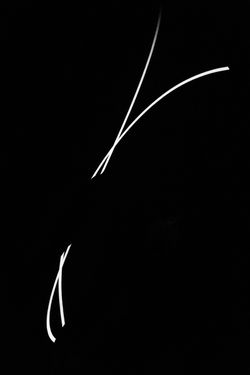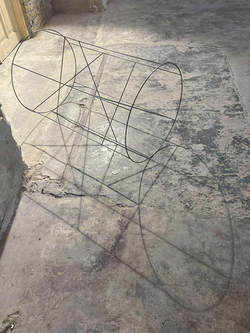
E = mc² – In Dialogue with Fern L. Nesson
October 9 – November 5, 2025, Budapest, Bakáts Bunker
 |  |
|---|---|
 |  |
 |  |
 |  |
 |  |
 |  |
 |  |
 |  |
 |  |
 |  |
 |  |
 |  |
 |  |
 |  |
 |  |
 |  |
 |  |
Click on the thumbnail to view the image. Click on the image for a larger view and information.
Collaborating Hungarian artists:
Diána Bóbics, Luca Gőbölyös, László Horváth, Vilmos Katona, Márta Nyilas, Dóra Palatinus, István Rigó, Sára Sebestyén, Rita Varga
Artist statement
Fern L. Nesson: E=mc²
Prior to 1905, physicists credited Newton’s description of the universe as a clockwork machine, in which time flows steadily forward through space that is an unvarying, regular grid. Not so with Einstein. When scientific experiments exposed flaws in Newton’s description, Einstein fearlessly thought his (and our) way out of the box. It was not light speed that varied; it was time and space. In fact, light is a constant, the fulcrum around which the universe balances, or, as Einstein put it, E=mc².
As ravishing, brilliant, evocative and world-changing as Einstein’s insight clearly was, I can’t help but wonder whether he would have come to it even sooner if he had been a photographer. Photographers know that everything revolves around light. The amount of natural light is not in our control. Without light, there can be no photo. But we can play with time; we control the shutter. Light is a photographer's constant; it is time that is relative.
Taking E= mc² as my starting point, I have explored its implications in science, art and life. My non-representational, abstract photographs are neither staged nor lit artificially. All are reality-based. The subject of my images is irrelevant. They are meant to capture the moment when mass becomes energy and to transmit their energy to you.
Roland Barthes asserts that "a photograph is a witness [to] what has been. Every image is an image of death." But Barthes is wrong. As Einstein showed us, the equation runs two ways: energy can transform into mass -- light and a camera produce the photograph -- but mass can transform into energy as well. A photograph may speak to a moment now past, if that is what is desired. Cartier- Bresson’s “decisive moments” do precisely that. But a photograph can create its own energy as well. Like Cezanne's paintings, it can live; it can breathe.
I use my camera to create life and to defy death. My goal is to make living works of art that remind us of our own transcendence. In a transcendent moment, we know ourselves to be infinite, inextricably a part of the universe. We perceive that, when we die, we will merely change in form. Nothing is ever lost. The energy of those we loved exists forever all around us. And we will too.
E=mc²
Biography
Fern L. Nesson is a fine art photographer whose work explores the boundaries between abstraction and perception, often transforming the ordinary into meditative visual experiences. With a background in law and history, her photographic practice reflects a conceptual engagement with time, movement, and meaning. Nesson’s minimalist imagery investigates the relationship between light and form, inviting viewers to experience stillness and intensity simultaneously. Her work has been exhibited internationally, including solo shows in Boston, New York, and Barcelona, and is held in several private and institutional collections.
Opening remarks by Gary Justis
Fern L. Nesson is a graduate of Harvard Law School. She received an M.A. in American History from Brandeis and an M.F.A in Photography from the Maine Media College. She lives in Cambridge, Massachusetts. She practiced law in Boston for twenty years and subsequently taught American History and Mathematics.
Nesson's photographs have been shown internationally in solo exhibitions at the Politecnico University in Torino, Italy, Les Rencontres de la Photographie in Arles, France, Ph21 Gallery in Budapest, Hungary and at The University of the West Indies in Kingston, Jamaica. In the United States, Nesson has had solo exhibitions at the Griffin Museum of Photography, at MIT and Harvard, and at the Beacon Gallery in Boston, Massachusetts, the Pascal Gallery in Rockport, and Maine, and Through This Lens Gallery in Durham, NC.
Taken from the Midwest Center for Photography’s PORTFOLIO PLATFORM 2024/2025
Quoting Fern Nesson from her website:
“Roland Barthes asserts that "a photograph is a witness [to] what has been. Every image is an image of death." Fern goes on: But Barthes is wrong. A photograph may speak to a moment now past if that is what is desired. But a photograph can create its own energy as well. Like Cezanne's paintings, it can live; it can breathe.”
I agree with this part of Fern Nesson’s statement. A photo does not only record history, it still asserts contemplative properties that reach our heretofore realized level of consciousness. The image might inspire the eye through both fact and fiction as observed, seeming to breathe a kind of luminous faith into our determined reality.
An image, on a flat surface, by its own right possesses more than it’s 2 dimensional identity. It owns territory in the 3rd and 4th dimensional realms, when we attempt to see it in an unbiased manner. This opens up our experience to it, perhaps causing an emotional connection, or a connection based in reason, or both correlations.
Whatever level of commitment we have to an image, we force it to a status that often establishes, in space, the real-time, original subject of the recorded image. In Fern Nesson’s photographs, we can assume the subjects are perpetually extant in the world. However, the original subject of a photo image will oftentimes become irrelevant in the world of objects and places over time, or in some cases, cease to exist, e.g., the wasting of organic material to base particles, the raising of a building, the deformation of a local scene in nature, etc.
Fern Nesson delivers us a directed experience in choosing the subject, liberating it from the visual restrictions of its autonomous surroundings. Directing, misdirecting, discovering the light and shadow to enhance elements, or cause them to vanish, manipulating with digital or analog processes…In that sense, the photographer is the survivor of an eternally mutable environment, and also a survivor with an autonomous product; proof on paper (or other printable materials).
In understanding the place Fern Nesson’s images occupy in the history of photography, I feel it’s important to briefly address the image’s contrast with photographs that contain the human figure. It’s an important distinction in the history of image making. I’ll address the human smile, which is intrinsic to commonplace or vernacular photography. In the case of the smile, a convention of the early 20th century, the image is locked more strenuously into its own historic identity. Human subjects like to convey the pleasantness of their experiences, whether they are congenial, or not. This emotional expression pre-positions the image to communicate an abstraction linked to real-time experience, which might be happening pre and post image capture. We tend to see time, during our experience of this type of photograph as a substantive fixture of measurable human-based occurrences.
Fern Nesson’s photographs challenge the human narrative by not including human bodies and expressions, yet they re-construct a type of techno-narrative in the juxtapositions of mysterious forms, and fields of light. They flirt with figuration through the power of the images, allowing the human imagination to enter the fields of activity. In many of the images, architectural elements explode, either from foreground to background or vice-versa. This beckons the eye to navigate provinces of activity and energetic potential. Yet other images present sinuous lines and lyrical relationships that convey a true sense of calm. Entry into these photographs distills a new-found faith in the world, and a belief that the 2nd dimension is alive, and viable as a medium of human experience. The images are to be entered, relished and consigned to memory and perhaps eventually appended, enduringly, to our collective consciousness.
This exhibition was supported by the Local Government of Ferencváros District (Budapest Főváros IX. Kerület Ferencváros Önkormányzata).


